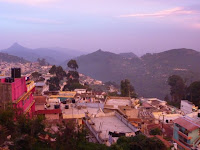
Whew! The sesshin ended this morning. It has been a long and contemplative five and a half days, probably the longest period that I have not communicated to anyone (I must confess that I did, however, sent one SMS to my significant other!). I actually enjoyed the silence as people generally tend to talk too much. Have I awakened yet? Far, far from it ……… but definitely finding traces of the ox (the second of a legendary series of ten Ox-Herding Pictures that represent the stages of the Zen journey – for more on Zen Buddhism see my probably futile attempt to describe the indescribable in the next posting).
As mentioned in earlier posting a sesshin is best described as an intensive meditation programme. The daily schedule for our sesshin is as follows:
05:00 Wake Up Call
05:30 – 07:00 Zazen (25min blocks of sitting meditation broken with 5min walking meditation) and Dukosan (a traditional Zen practice where master meets one-on-one with student)
07:00 Breakfast
08:00 – 09:00 Samu/Seva (selfless service – similar to Karma Yoga in ashram - where we are each assigned a specific task)
09:15 Tea
10:00 – 11:00 Zazen
11:00 – 11:30 Free Zazen (independent sitting meditation outside zendo/meditation hall)
11:30 – 12:30 Zazen
12:30 Lunch
14:30 – 16:00 Zazen
16:00 Tea
17:00 – 19:00 Zazen and Teisho (another traditional Zen practice where master talks on the Dharma)
19:00 Supper
20:00 – 20:45 Zazen
In one day we would have meditated for 15 sessions – about 7½ hr. That’s a lot of meditation time but this is generally typical of a sesshin program whose sole and only purpose is to meditate, meditate and meditate. By the end of sesshin most of us were understandably drained (physically and mentally) and were quite relieved to see the end of it. Fortunately the asana and pranayama practice during my two weeks stay at the yoga ashram had helped me cope reasonably well with the physical aspect but just sitting still and following the breath for 7½ hr a day can be extremely difficult. The quality of meditation varies from sitting to sitting. During a good sitting when the mind is sufficiently calm glimpses of Emptiness are experienced. Within this vast, timeless, and silent space impressions arise without mental interpretations ….…….. a chorus of cicadas, the chirping of birds, the calls of wild peacocks, the slamming of doors, the swallowing of saliva, the clearing of throats, a cool breeze, the creaking of bones, the shifting of bodies, the scent of incense, a waft from the kitchen, unintelligible chattering of locals, distant honking of cars, buzzing of flies, humming of mosquitoes, groaning of tummies, strains of Tamil songs, etc., etc. And then the mind interrupts, intervenes and interprets – loud, sweet, beautiful, irritating, etc. – and, in an instance, Emptiness becomes Form again. On a bad sitting the monkey mind cannot be restrained and continually wanders – the pain in my ankle/knee, is my spine erect enough?, is my lower back arching properly?, the cooking smells lovely, what’s for lunch today?, my body is too tense, my body is too relax, it’s about bloody time, the bell must go soon, and so on and so forth. Zazen is fundamentally a meditation practice - the more we practise, the better the concentration gets.
“So meditation, why bother?” ……… a rhetorical question posed by the American Zen Master, Jun Po, with whom I did my first sesshin last March. Zazen is central to the Zen tradition and is the practice of seeing into your true Self. Followers of the Zen way believe that Buddha-nature is within each of us and this can be realised through zazen. However, Jun Po argued that meditation itself will not bring us this realisation. Firstly the mind has to be transformed/reframed/reindoctrinated to have the conviction that Buddha-nature is within us and, only then, meditation practice can reveal this true Self. Meditation with an incorrect understanding not only limits our insight, but can lead to suppression of feelings, rigid self identification, ego-inflation, mania or nihilism. Having a sitting practice is one of the most important steps one can undertake to awaken. But knowing exactly why you are sitting—having the right philosophical framework—is equally important.
The other effect of the sesshin is my heightened sensitivity to the surrounds. I am acutely aware of the different sounds. The sky has a deeper blue. I discern different shades of green. Colours of flowers seemed brighter and bolder. I perceive the swaying of trees and the subtle movement of leaves. Even the light has a different quality. The environment exudes such joyfulness that just to be alive and be part of it is enough. No, I am not on drugs but the feeling is quite similar. And this is only after five days of silent meditation retreat. Just imagine how a year of such intense practice can alter your perception of the world!
I must mention the glorious vegetarian meals here. That probably is what kept the forty or so of us (a global representation, including a fair number of locals, of mainly baby boomers with diverse spiritual inclinations) going. Breakfast is usually a variety of local morning snacks (idly, vadai, oothappam), home-made bread (toasted if desired), cereals, porridge, fruits and the occasional fried eggs. Tea and brewed coffee are always available. Lunch, the main meal, is the highlight of the day and is eagerly awaited – especially since this is straight after 2½ hr of sitting. The cooks continuously surprise us with some amazing dishes. The different types of curries (I suspect most of the vegetables are home grown) just taste divine. After a week here I still look forward to lunch daily. I have another three weeks here and I will endeavour to ingratiate myself with the cooks and uncover the wonderful recipes before I leave. Afternoon tea is served with a local delicacy and supper is a simple but still delicious affair (usually chappathi with dhal curry or some kind of soup).
I will leave you with one of the most venerated Buddhist sutras (we have to chant this sutra at least twice daily!). I think it is worth a few readings if you have an interest in Buddhism. Enjoy!
Avalokitesvara, an Awakened One of great compassion, experiencing the clear deep truth of the transcendent wisdom of meditative awareness, clearly saw that all of the images, thoughts, feelings and emotional states of ego mind are empty of any permanent self-nature. Realizing this, he immediately transcended mental confusion and ego suffering and told Shariputra:
Remember that all manifested forms are no other than this emptiness. Emptiness is no other than all these manifested forms. Form is exactly emptiness, emptiness is exactly form. All of our thoughts, feelings, concepts, conscious states and volitional actions are also like this. We must remember that even spiritual life and practice are fundamentally empty. Within this deep meditative awareness, there is no birth, no death, nothing can be defiled, nothing is pure, nothing can increase, nothing can decrease. Hence, in this emptiness, there is no form, no
feeling, no thought, no volition, and no consciousness. There are no eyes, no ears, no nose, no tongue, no body, and no mind. There is no seeing, no hearing, no smelling, no tasting, no touching, and no thinking. There is no world of sight, no world of consciousness. There is no ignorance and no end to ignorance. There is no aging leading to old age and death and no end to aging leading to old age and death. There is no suffering, no craving, no extinction, no path, no wisdom and no attainment. Indeed, there is nothing to be attained.
The Awakened Ones rely upon this transcendent wisdom and experience no ego confusion or hindrance in this mind. No hindrance, therefore, no fear. Far beyond upside down views at last, this enlightened mind we call Nirvana. Past, present and future, all Awakened Ones, all compassionate ones, rely upon this transcendent wisdom of meditative awareness and, therefore, experience the most supreme awakening: Enlightenment.
Thus, know that transcendent wisdom is the greatest dharani, the brightest dharani, the incomparable dharani. This practice can completely clear the mind and end all ego suffering. This is the truth, not a deception. So embody this transcendent wisdom, manifest this wisdom, proclaim this dharani and Awaken!
Gate, Gate, Para Gate,
Parasam Gate,
Bodhi Swaha!













